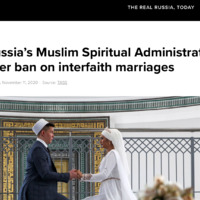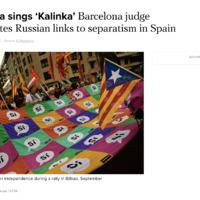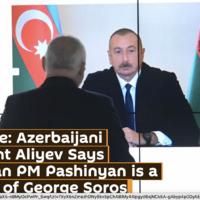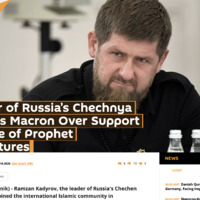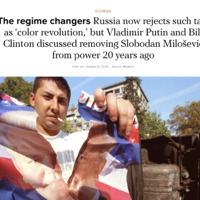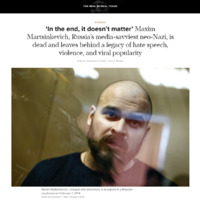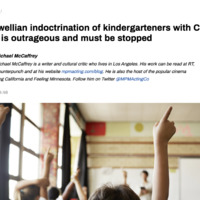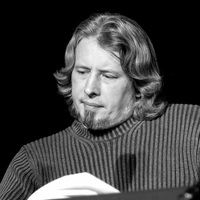RUSS 005 - Omeka Project - Christopher HC Zhao
Race, Ethnicity, Nationality: A Globalized Outlook of Russia's Government and Contemporary Society
“Russia is a riddle wrapped in a mystery inside an enigma" — Winston Churchill, 1939
Introduction
“Russia is a riddle wrapped in a mystery inside an enigma,” claimed the future British Prime Minister, Winston Churchill, in 1939. Until today, Churchill’s words resonate with the Western public as they are still largely unacquainted with Russian society. A centerpiece of this enigma is Russia’s long-lasting ethnic question, given that it subtly extends to various domestic and international conflicts.
Being a transcontinental global superpower with a population of over 140 million, Russia is characterized by its ethnic, cultural, and religious diversity. While ethnic Russians constitute approximately eighty percent of the population, minority groups, primarily Chechens, Tatars, Armenians, and Chuvash, also contribute to the melting pot.
During the Stalin era, the government pursued Russification to solidify a common national identity, despite undermining the unique cultural heritage of the ethnic minorities. Following the Soviet Union’s disintegration, there was a revival in regional language and culture in Russia, since the marginalized population gained greater freedom.
In the contemporary era, along with Russia’s increasing influence in the global arena, Russia’s domestic ethnic issues become highly intertwined with global affairs and other ongoing contentions. On one hand, Russia’s approach to its internal ethnic conflict is a representation of the power struggle between Slavic and Turkic influence on a global scale; on the other hand, Russia’s response to global ethnic controversies manifests its consolidation of power and rejection of Western ideology. Besides, the recent rise of alt-right movements in Russia targeting ethnic minorities is also a radical anti-establishment protest. For this reason, the multifaceted nature of Russia’s ethnic conflict continues to assume a vital role in its international and domestic policy.
Map of Former Soviet Union's Ethnic Distribution

The Issue
Reconciliation Between Ethnic Majority and Minority
Similar to many multiethnic states, Russia struggles to reconcile the ethnic majority and minority groups. A hotspot for Russia’s ethnic conflict is the Northern Caucasus, a predominantly Muslim region located in Russia’s southwestern frontier. Throughout history, the region has been contested between Turkic and Slavic peoples. After being integrated into the Russian Federation, many Muslims in the region were unsatisfied with their subordinate position in society. Due to Moscow’s pervasive influence, the local people, along with Muslims from other parts of Russia, have constantly sought greater autonomy and representation in government. Noticeably, certain groups have taken a radical stance on preserving Islamic customs in their communities. For instance, the Russian Muslim Spiritual Administration headquarters recently forbade interreligious marriage between Muslims and those with other beliefs. This controversy reflects Russia’s incapability to tilt the power asymmetry between ethnic groups. In response to this failure, the minority groups either futilely strive for intercultural harmony or isolate themselves to practice their traditions. As empowering the marginalized population remains a challenge, Russian society will further polarize these relations in the predictable future.
Global Indications
Meanwhile, the government’s attitude regarding domestic and international ethnic tensions and nationalist movements are highly intertwined with its overarching political objective. Vladimir Putin, the long-serving president of Russia, prioritizes exerting greater influence on the global community during the policymaking process. As a part of these actions, he incessantly seeks to destabilize the Western democracies and reject the influx of Western ideologies in Russia. In particular, Russia’s alleged clandestine support for Catalonia’s independence referendum is an effort to intensify the divide within the European Union. Ironically, Russia overtly emphasizes the importance of sovereignty in the global arena. When addressing former Yugoslavian president Slobodan Milosevic’s crimes against ethnic Bosnians during the Yugoslavian War, the Russian national press denounced Western states for plotting “color revolutions” intended to overthrow Milosevic. By making this announcement, Russia strengthens its harsh stance against the West’s intervention in Russia’s internal affairs. The discrepancy between Russia’s response to these two international events reflects that the government does not follow a fixed standard regarding ethnic and nationalistic tensions. Instead, the government uses it as a guise when pursuing political interests. When Russia’s attempts to resolve ethnic conflicts pertain to its larger political ambitions, they will likely remain ineffective.
Alt-Right Movements
Putin’s approach to ethnic issues provoked dissatisfaction among the Russian citizens from various groups, more than just the ostracized population. Surprisingly, Russia’s recent surge of neo-Nazi movements is also a form of protest against the government establishment. From their perspective, the government forcefully obliterates the preexisting hierarchy and Russian domination when integrating minority groups and immigrants into society. Through this process, the government preserves its authority by constructing the shared multiethnic Russian identity, which is against the alt-rights’ beliefs. According to Maxim Martsinkevich, a well-known neo-Nazi media personality who recently died by suicide, the Russian government neglects the ramification of Soviet Union's disintegration, that is, the inclusion of multiethnic culture diluting the conventional Russia values. On the contrary, many minority groups protest against the disappearance of indigenous cultures, citing that Putin’s stance on Russia’s minorities represents a case of déjà vu to the Stalinist assimilation policy. Following Russia’s decision to make the Udmurt language optional in the local region, Albert Razin, an Udmurt activist self-immolated in front of the government building to protest. Despite holding drastically different concerns, the alt-right groups and the persecuted minorities both consider themselves victimized by Putin’s policy, which prioritizes the consolidation of power. That said, the ethnic controversy in Russia highlights its predicament to find equilibrium between the centralized power and its people’s voices.
Supplemental Videos:
Textual Representation
The pervasive ethnic question in Russia is well depicted in contemporary Russian literature. In The Mountain and the Wall, author Alisa Ganieva discusses a hypothetical scenario in which Dagestan is separated from the rest of Russia following the construction of a border wall. Throughout the story, Dagestan experiences the rise of a form of Islamic fundamentalism that aims to restore strict adherence to the Quran in society. This ideology confronts the movement that promotes interfaith harmony. The intention behind the wall in the story remains unclear. A possibility is that Moscow wishes to fend off the Islamic influence from the rest of Russia, and another possibility is that the Salafist Dagestan government isolates itself from the secular Russian society. Regardless of the motive, the wall is a potent representation of Russia’s ethnic divide. Under the story’s fictional situation, this chasm cannot be reconciled, so that isolationism becomes the only option. In contrast, the mountains in the story unites people of all background in rejoice with their common affection toward the landscape. For this reason, establishing solidarity among the people still seems like a far-reaching aim. With the dichotomy between unity and division, The Mountain and the Wall admonishes the consequences of the ethnic divide in Russia and encourages interfaith dialogue.
"Dagestan … Just think how small it is, and yet how many peoples and customs, languages and arts, animals and plants, coexist here... We Dagestanis, all of us, are very different, but we are alike in our society, hospitality, our need for justice." (Ganieva, 216)
The Mountain and the Wall features a manuscript from a fictional Dagestani writer Makhmud Tagirovich. In his work, Tagirovich envisions his homeland openly embracing diversity within the population regardless of the ongoing tensions, acknowledging the population's common desire for justice and amiability. From his perspective, the people can reconcile its tension and rejoice together. In a multiethnic region, finding commonality within the population is arduous, but at the end of the day, the shared virtues of mankind can bridge all the differences.
Another literary work that addresses the dilemma between unity and division is Day of the Oprichnik by Vladimir Sorokin. Based on a dystopian, futuristic vision of Russian society following the restoration of the Tsardom, the story depicts a day in the life of the Andrei Komiaga, a loyal assistant to His Majesty. Along with his cohort, Komiaga persecutes a duke who has challenged the tsar's authority, inspects a poem publication, injects a fish-shaped drug that provides hallucinations, and practices a grotesque ritual involving group sex and torture. All these activities intend to preserve the dominance of the authority. Furthermore, the group sex activity orchestrated by the cohort is self-humiliating, turning themselves into soulless individuals devoid of personal identities. Simply put, Day of the Oprichnik is an exaggerated depiction of Russia’s authoritarian tendencies.
An underlying motif of the story is xenophobia against foreign populations, especially the Chinese. Throughout the story, the Chinese immigrant population has assumed a pivotal role in the Russian society, dominating the trade sector. In response to the Chinese influence, the Russian population shares a mixed feeling. Noticeably, there are racist and stereotypical portrayals of the population from the perspective of certain characters in the Tsardom. While it is unclear whether such attitudes reflects the mainstream futuristic Russian society, it is certain that a significant population exhibits similar feelings. The presence of xenophobia resonates with Russia's authoritarian past, especially during the Stalin Era, in which ethnic minorities were relocated to the frontiers to engage in arduous laboring. That said, the escalating ethnic tension and exclusive action can be considered as a ramification of authoritarianism.
Apart from xenophobia, the book's overarching theme lies behind the role of state and collective memory, which closely coincides with the ethnic issues in the modern era. As the Putin regime reinforces collectivism in the mainstream narrative, the distinct characteristics of individuals, as well as minority groups, are under-protected. Although maintaining a centralized power enhances Russia’s stability, it will inevitably challenge the unique features that make the diverse ethnic groups in the country special.
Conclusion
Ethnic issues have been a ubiquitous challenge for multiracial countries. In the contemporary era, marginalized groups have gradually gained momentum to call for equality and maintain their unique heritage. Simultaneously, the concurrent alt-right movements have posed a menace to inter-ethnic harmony within the countries. While the Russian government continues making an effort to resolve ethnic issues within its borders and support certain sides in international conflicts, its initiative intertwines with other political motives, especially the consolidation of power and the delegitimization of Western democracies. For this reason, alleviating ethnic issues domestically and worldwide remains arduous for Russia. In the future, empowering minorities remains an essential part of its agenda. Given that the most impoverished frontiers are predominantly settled by minority groups, it is important to grant economic assistance to the region along with other promises, such as greater representation in government. Likewise, the state should reevaluate its focus on domestic and international affairs and redistribute its power structure. With these changes in place, the status quo will likely improve.
Work Cited
- Cowell, Alan. “Churchill's Definition of Russia Still Rings True.” New York Times, 1 Aug. 2008.
- Ganieva, Alisa, et al. The Mountain and the Wall. Deep Vellum Publishing, 2015.
- Sorokin, Vladimir, and Jamey Gambrell. Day of the Oprichnik. Penguin Books, 2018.
